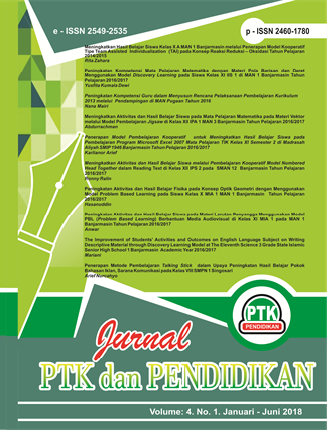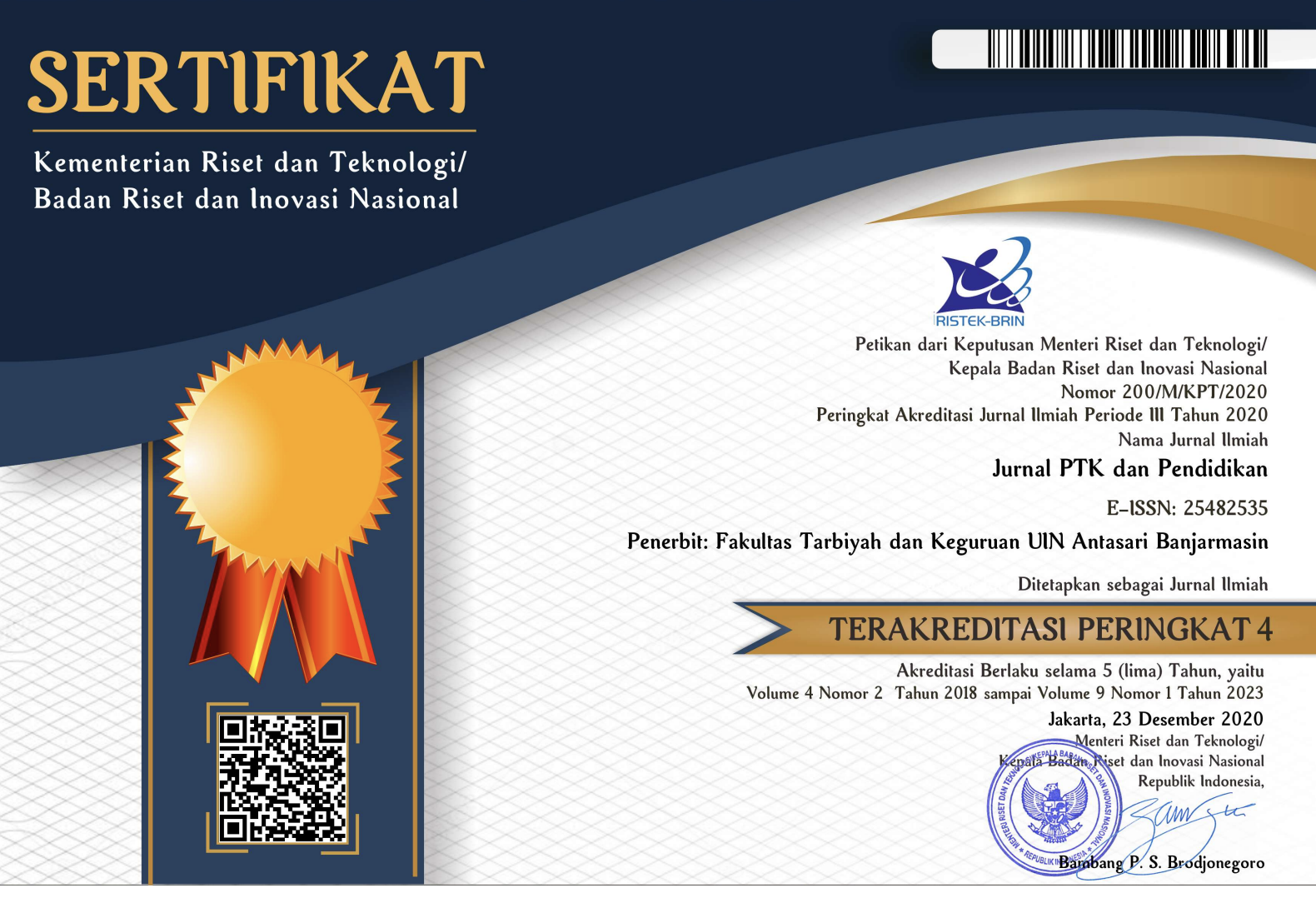Penerapan Metode Pembelajaran Talking Stick dalam Upaya Peningkatan Hasil Belajar Pokok Bahasan Iklan, Sarana Komunikasi Pada Kelas VIII SMPN 1 Singosari.
DOI:
https://doi.org/10.18592/ptk.v4i1.2123Abstract
Scope of the Indonesian Language Subject to the basic education level (VII-IX) is as follows. The text-forming language units: language sounds, phonemes, morphemes, words, word classes, phrases, clauses. The language marker in the text. Paralinguistik (pronunciation, abbreviation, intonation, tempo, gesture, and mimic). The text structure of the story genre (text eksemplum), factual genre (text recording experiment) and response genres (challenge text, critical responses). The cultural context, norms, and social context behind the birth of the text type.The results of this study indicate that the learning outcomes in the second test meeting cycle I showed an increase. The first increase is the grade value of the previous grade is 67.63. At the second meeting the first cycle increased to 76.94. Furthermore, in the range of values 76 - 100 has a percentage of 31.25% increased to 62.5%. that the learning outcomes in the first meeting test in the second cycle showed a significant increase. In the second cycle as a whole mastery of students on the material review patterns, structure and linguistic rules of advertising reached 84.38%.References
Ahmad Rohani. 2004. Pengelolaan Pengajaran. Jakarta: Rineka Cipta,
Agus Suprijono. 2009 Cooperative Learning Teori dan Aplikasi PAIKEM.
Yogyakarta : Pustaka Pelajar.
Anita Lie. 2002. Cooperative Learning Mempraktikkan Cooperative
Learning di Ruang-Ruang Kelas). Jakarta: PT. Grasindo Widia Sarana
Indonesia
Arifin. 2010. Penelitian Pendidikan : Pendekatan Kuantitatif dan Kualitatif. Lilin
Persada Press.
Basrowi & Suwandi. 2008. Memahami Penelitian Kualitatif. Jakarta : Rineka
Cipta.
Bobbi De Porter. 2000. Quantum Teaching/Learning. Bandung : Kaifa.
Departemen Pendidikan Nasional, 2003. Undang-Undang Nomor 20 Tahun 2003,
Tentang Sistem Pendidikan Nasional, Jakarta: Depdiknas.
Departemen Pendidikan Nasional. 2006. Kurikulum Tingkat Satuan Pendidikan
(KTSP). Jakarta:Departemen Pendidikan Nasional.
John Jarolimek. 1993. Sosial studies in Elementary Education (9th.Ed). New
York: Macmilan Publishing.co.Ltd)
Kokom Komalasari. 2011. Pembelajaran Kontekstual Konsep dan Aplikasi.
Bandung : PT Refika Aditama
Kunandar. 2012. Langkah Mudah Penelitian Tindakan Kelas Sebagai
Pengembangan Profesi Guru. Jakarta : Rajawali Pers.
Muhammad Asrori. 2012. Penelitian Tindakan Kelas. Bandung: CV Wacana Prima
Mulyasa, 2004. Implementasi Kurikulum Tingkat Satuan Pendidikan Kemandirian Guru dan Kepala Sekolah. Bandung: PT Remaja Rosdakarya.
Mustakim. 2007. Keefektivan Model STAD dan Jigsaw pada Pembelajaran Menyunting Siswa Kelas VIII SMP Negeri 1 Mertoyudan Kabupaten Magelang Tahun Pelajaran 2006/2007.Tesis. Semarang: Program Pascasarjana UNNES.
Peraturan Pemerintah No 19 Tahun 2005. Standar Nasional Pendidikan.
Peraturan Menteri Pendidikan Nasioanal nomor 22 tahun 2006 tentang standar isi
Rachmad Widodo. 2009. Model Pembelajaran Talking Stick. [Online] Tersedia pada http://wyw1d.wordpress.com/2009/11/09/model-pembelajaran-16-talking-stik/(diakses tanggal 15 Juli 2017).
Ramadhani Masykur. 2011. Penerapan Metode Pembelajaran Talking Stick
Untuk Meningkatkan Prestasi Belajar Siswa Pada Pokok Bahasan Koloid
Di Kelas Xi Ipa Sma Negeri 7 Pekanbaru. Universitas Riau
Wina Sanjaya. 2006. Strategi Pembelajaran. Jakarta : Kencana Prenada Media Group.
Wina Sanjaya. 2006. Strategi Pembelajaran: Berorientasi Standar Proses Pendidikan. Jakarta: Kencana
Subana, M. Strategi Belajar Mengajar Bahasa Indonesia: Berbagai Pendekatan, +Metode Teknik, dan Media Pengajaran. Bandung: Pustaka Setia.
Sumarno, 2003. Pendidikan Kewarnegaraan. Jakarta: PT Pustaka Tiga Kelana
Sumiati & Asra. (2009). Metode Pembelajaran. Bandung: CV Wacana Prima
Downloads
Published
How to Cite
Issue
Section
License
- The right to publication of all journal material published on the Jurnal PTK dan Pendidikan website is held by the editorial board with the author's knowledge (moral rights remain the property of the author).
- The formal legal provisions for access to digital articles of this electronic journal are subject to the terms of the Creative Commons CC BY 4.0 DEED Attribution International (CC BY) license. This license enables reusers to distribute, remix, adapt, and build upon the material in any medium or format, so long as attribution is given to the creator. The license allows for commercial use.
- Printed and electronic published manuscripts are open access for educational, research and library purposes. In addition to these objectives, the editorial board shall not be liable for violations of copyright law.







